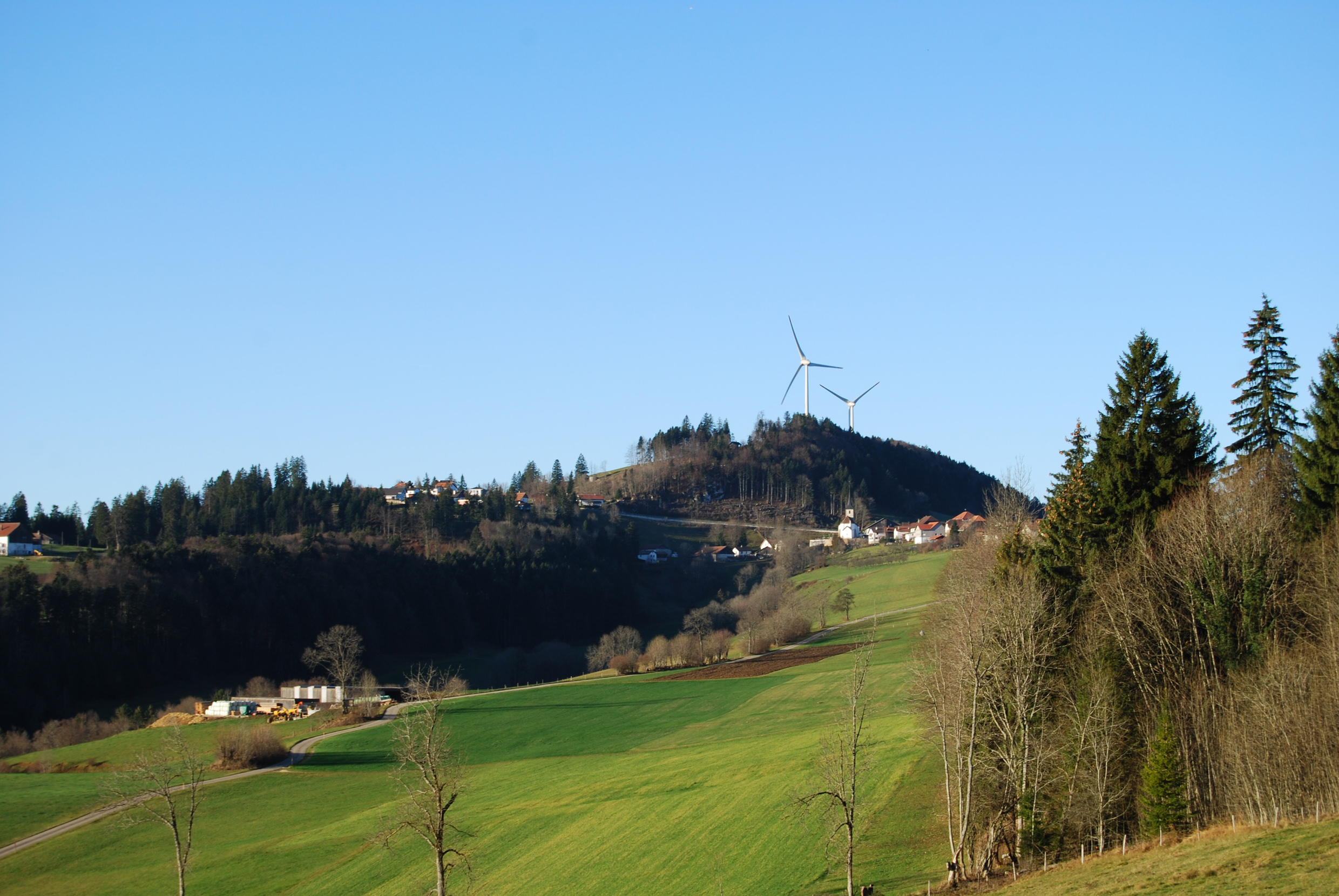
Turbine protestors have the wind in their sails

Wind turbines are springing up on the hills of the Jura in western Switzerland, but local opposition to them is getting more and more organised.
At the beginning of October, the people of Bourrignon, on the heights above the Jura cantonal capital of Delémont, voted against a plan to erect 14 turbines near their village.
Several communes in the Franches-Montagnes region of the Jura are to vote shortly on initiatives calling for either a total ban, or a moratorium, on the construction of industrial wind turbines.
Encouraged by these successes, the anti-turbine activists are continuing their fight.
The group Sol-E, a subsidiary of BKW energy, wants to erect 11 turbines above the industrialised village of Tramelan , in the Bernese Jura in the next few years. Although the project is still only at the study stage, feelings are running high.
Beware ice blocks!
Opponents of the project invited villagers to a public meeting at the end of October. It was a polished performance, with dramatic images and touching personal accounts.
“We are not anti-turbine, but we simply want the rights of people living in the neighbourhood to be respected,” said Roland Schweizer, one of the organisers of the meeting.
Under Swiss federal law, there must be at least 300 metres between a wind turbine and any houses. But opponents say practically all other European countries have much stricter norms.
If the Sol-E project is built, some farms would be surrounded by three turbines, barely 300 metres away, Schweizer claims.
The list of annoyances caused by turbines is hair-raising: unbearable repetitive noise, a strobe effect from the shadows cast, huge blocks of ice hurled into the air, which could be a danger to cross-country skiers, to name but a few.
Living – or not – with turbines
Karine Froidevaux, who lives near the turbines in Peuchapatte gave an emotional, almost tearful, account of her experience.
“I’m going through hell. The turbines have robbed me of everything. At night I am forced to sleep in my office. And I can’t forget them in the daytime: they are all around me. And when they aren’t turning, I can’t stand the creaking they make.”
The hall burst into applause.
Marc Suter, a lawyer, and member of the Swiss Committee for the Protection of the Countryside, looked at the issue from a less emotional angle. He criticised the legal void at federal level, pointed out that erecting turbines was incompatible with the law on rural planning, and said the local authorities had not weighed up the balance of interests properly.
The contract signed with the power companies could bring in a lot of money to the commune and to landowners, but the economic impact would be largely negative, he claimed.
This view was backed by local industrialist Martial Voumard, who told the meeting he was worried by the threat to the quality of life and the unspoiled countryside, which are what make this marginal region attractive.
The value of housing was likely to fall by 20 per cent, qualified staff would leave and the long-term survival of family businesses in the village would be endangered.
“Stealing” the countryside
After a film, shot from a helicopter, which had added in virtual images of the planned turbines, the villagers had their turn to ask questions and to comment.
They didn’t mince their words about the power companies, whom they accused of “stuffing their pockets”, or about the “people of the plain”.
“Bigwigs from the towns are coming to steal our countryside,” said one.
“I won’t have our mountains sacrificed to warm the cold beds of Lausanne and Montreux!” said another.
Only one dissenting voice was heard, from someone who said they weren’t bothered by turbines, and said the differences of opinion were as arbitrary as differences in taste.
The mayor of Tramelan pointed out that at the moment the project was still at the study stage. She promised that nothing would be done before villagers had had a chance to vote on it.
Lack of solidarity
Reto Rigassi, director of Suisse Eole, the association for the promotion of wind energy set up by the Federal Energy Office, was unable to make much impression on the hostile meeting.
“We have a collective responsibility. Eighty per cent of the energy we consume is not renewable, and we have to find solutions,” he told the gathering.
Speaking to swissinfo.ch after the meeting, he said that everything is being done to reduce the impact of turbines as much as possible.
“Legislation on the noise is much stricter than it is for the railways and motorways,” he pointed out.
He regretted the lack of solidarity shown by people who “also benefit from the infrastructure of the towns” but don’t want to put up with the annoyances.
“Everyone has to play their part in the major changes in energy that we face. If we all insist on hanging on to our maximum comfort, we will suffer the same fate as the Romans and disappear.”
In 2010 electricity consumption was up 4% in Switzerland on 2009, at 59.8 billion kWh, according to the Federal Energy Office.
Switzerland’s five nuclear power reactors generate 39.3% of the country’s electricity; Hydro-electric stations produce 55.8%.and conventional power stations 2.9%.
New renewable sources (solar, wind, bio-fuel and biogas) are responsible for about 2%.
In 2010, Switzerland imported 66.8 billion kWh, and exported 66.3 billion.
After the disaster at the Fukushima nuclear power station in Japan, the Swiss government and parliament decided to gradually close down existing nuclear power stations and not build any more.
Switzerland intends to be nuclear power free by 2034.
Switzerland currently has 28 industrial wind turbines, in 8 different locations, 3 of them in the Jura mountains. Their output is estimated at 74 million kWh, equivalent to the consumption of 21,000 households.
Switzerland is home to the highest wind park in Europe, at 2330 meters above sea level, near Andermatt. An even higher turbine, at over 2,400 meters, near the border with Italy, is due to become operational in 2012.
Another 17 projects, for the construction of 127 turbines, are currently at the planning stage. More than half of them are in the Jura mountains. They are due to be built by 2016. Other potential sites in the Alps and Jura are currently under discussion.
A concept for wind energy in Switzerland issued in 2004 said that wind energy could cover 2.5 of the country’s energy needs in 2035, and 6.8 % in 2050, the consumption of more than a million households. This would require the input of 800 industrial turbines.
(Translated from French by Julia Slater)

In compliance with the JTI standards
More: SWI swissinfo.ch certified by the Journalism Trust Initiative





























You can find an overview of ongoing debates with our journalists here . Please join us!
If you want to start a conversation about a topic raised in this article or want to report factual errors, email us at english@swissinfo.ch.